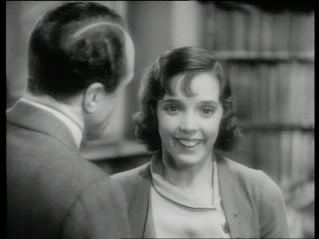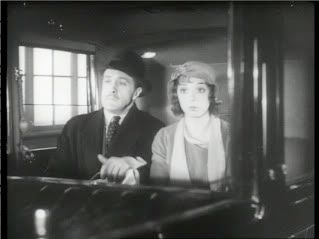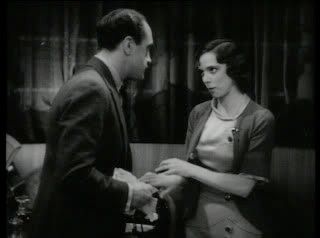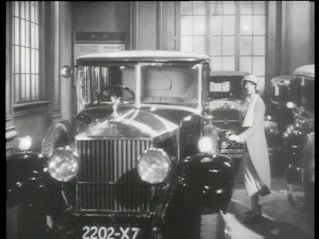

|
 |
There Goes the Bride
R2 - United Kingdom - Network Review written by and copyright: Paul Lewis (25th May 2009). |
|
The Film
 
Having begun her career as a chorus girl in London revues, the musical star Jessie Matthews first graced cinema screens (as a leading actress) in the 1931 film Out of the Blue (Gene Gerrard & J. O. C. Orton). Her appearance in that film convinced Michael Balcon to sign Matthews to a two year contract with Gainsborough. Matthews eventually made thirteen films for Gainsborough, the last of which was produced in 1938. With the later films Evergreen (Victor Saville, 1934) and The Good Companions (Victor Saville, 1934), Matthews made an international impact in films that were designed to compete with the spectacle of Hollywood musicals by such luminaries as Warners’ Busby Berkeley and RKO’s team of Fred Astaire and Ginger Rogers. Made prior to Matthews’ international stardom, There Goes the Bride was her first film for Gainsborough; the film features an early screen performance by Matthews, who is here directed by Albert de Courville, a successful stage revue producer who according to legend was ‘sadistic’ towards Matthews, to a point where Matthews was reputedly prepared to turn her back on her film career (see Macnab, 2000: 74). 
In There Goes the Bride, Matthews plays Annette Marquand; Annette is introduced gazing at a photograph of Rudolph San Carlo (Basil Radford), the man she is to marry. However, the wedding seems to have been arranged solely to benefit the business arrangements of Annette’s father. Annette’s fiancé is obliged to leave the country after 24 hours have passed, whether the wedding has gone ahead or not. With this in mind, Annette flees to France, planning to return after her to-be husband has left England, thus avoiding their marriage. However, on the train Annette’s purse is stolen whilst she is asleep. Awakening, Annette wrongly suspects the other passenger in her carriage, Max (Owen Nares), of stealing her purse. Believing Max’s bag to be her own, Annette tries to grab the item whilst Max is asleep. However, she disturbs Max, who wakes and accuses Annette of attempted robbery; at her protests of not having ‘a penny’, he sarcastically declares ‘That’s new!’ Through a series of coincidences, Max is effectively railroaded into offering shelter to Annette. Things become more complicated when Max receives a telegram announcing the imminent arrival of his fiancée Cora (Carol Goodner). 
The film offers a comedy of manners: played by Owen Nares, Max is stereotypically ‘proper’ and afraid of being seen to do the ‘wrong thing’: he is concerned that in sheltering Annette, his humanitarian gesture will be seen as a display of sexual interest in the young woman. Thus Max goes to great pains to hide Annette’s presence from Cora. Later, Annette is mistaken for Max’s fiancée by Max’s drunken friends, who make a late-night stopover at Max’s apartment. Eventually, Max and Annette find themselves at a party where Annette masquerades as Max’s absent fiancée; there the pair are placed at the heart of a jewel theft. For the most part, the film’s comedy is based on strong sexual innuendo. Told by Max that ‘This is a bachelor’s apartment’, Annette asserts that ‘I’m not afraid of bachelors: married men are the worst’. When Max tells his French cook Marie (Winifred Oughton) that Annette will be staying the night, Marie gives Annette a suspicious glance; to Max’s embarrassment, Annette responds by nodding towards Marie and declaring, ‘I suppose she’s used to it’. Later, Cora storms out of the apartment after discovering Annette’s presence, and holding up Cora’s outergarments Annette declares that Cora has ‘walked out into the night in her knickers’. A cut to outside the building shows Cora asking a man for directions to the Hotel Anglais; indignantly putting her hand on her hips, she accidentally displays her ‘knickers’, and the man responds by lustfully stating ‘Oohhh, mademoiselle’, only to be greeted with a slap. Meanwhile, Max wonders, ‘What will people say?’ Annette responds by declaring, ‘They’ll think she’s everybody’s… fiancée’. The implication is clear: Cora has been mistaken for a Parisian prostitute. In light of the risqué humour on show, the BBFC ‘U’ certificate awarded to the film on its original release is something of a surprise. 
Nevertheless, despite this reliance on sexual innuendo the film’s sense of humour never becomes vulgar. This is partly due to Matthews’ presence: she invests the character of Annette with a nervy innocence. When, following an argument, Annette demands that Max let her roam the streets of Paris whilst he goes to a party with his friends, Max declares, ‘But damn it, woman: you don’t know what might happen to a woman in Paris at this hour’. Annette responds by simply asserting, ‘No, but I’ve often wondered. Perhaps now I’ll find out’. In another actress’ hands, this exchange may have been quite seedy; but thanks to Matthews’ wide-eyed delivery, Annette’s response seems symptomatic of the character’s naïvete – rather than the vixen-like interest in the sexual underbelly of Paris that is suggested by the line as-written on the page. 
With some good musical interludes (courtesy of Fred Raymond) and the effervescent presence of Jessie Matthews, There Goes the Bride is a good example of early-1930s British musical comedy. The film makes an interesting counterpoint to the more fast-paced spectacle-driven musicals that were being produced in Hollywood during the same period – for example, Gold Diggers of 1933 (Busby Berkeley, 1933). It also makes an interesting counterpoint to Matthews’ later films, which with their Art Deco sets and their more incident-driven narratives were more obviously designed to compete with comparable Hollywood pictures and appeal to an international audience. 
The film runs for 76:49 mins (PAL) and is uncut.
Video
The film is presented in its original Academy screen ratio of 1.33:1. The monochrome image is clear and detailed but suffers from some minor wear and tear – nothing more than is to be expected from a non-Hollywood film of this vintage. There are some brief portions of the film where the image looks a little burnt-out, and there are other sequences that are very dark. However, on the whole the image is quite stable.  
Audio
Audio is presented via a two-channel mono track. This is clear, if a little low at times. Again, this suffers from a little wear and tear, which is to be expected from a film of this age.
Extras
The sole extra is an image gallery (0:41).
Overall
A good-humoured Gainsborough comedy, There Goes the Bride is a great vehicle for the charming Jessie Matthews. Less of a sop to the American market than Matthews’ later films, There Goes the Bride is a strong example of early British sound cinema. This DVD contains a fine presentation of the film; fans of early British cinema should find much to enjoy here. References: Macnab, Goeffrey, 2000: Searching for Stars: Stardom and Screen Acting in British Cinema. London: Continuum For more information, please visit the homepage of Network DVD.
|
|||||

|